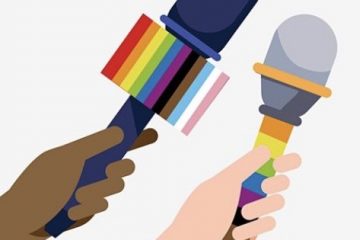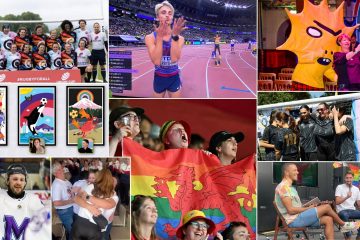Sports Media LGBT+ survey results show effects of increased visibility in industry
Network, advocacy and consultancy group releases findings from its second survey; responses suggest industry is more LGBT+-inclusive now than in 2018 but several challenges remain, particularly for trans and non-binary employees; “strong correlation between LGBT+ visibility in the workplace and responsible reporting”
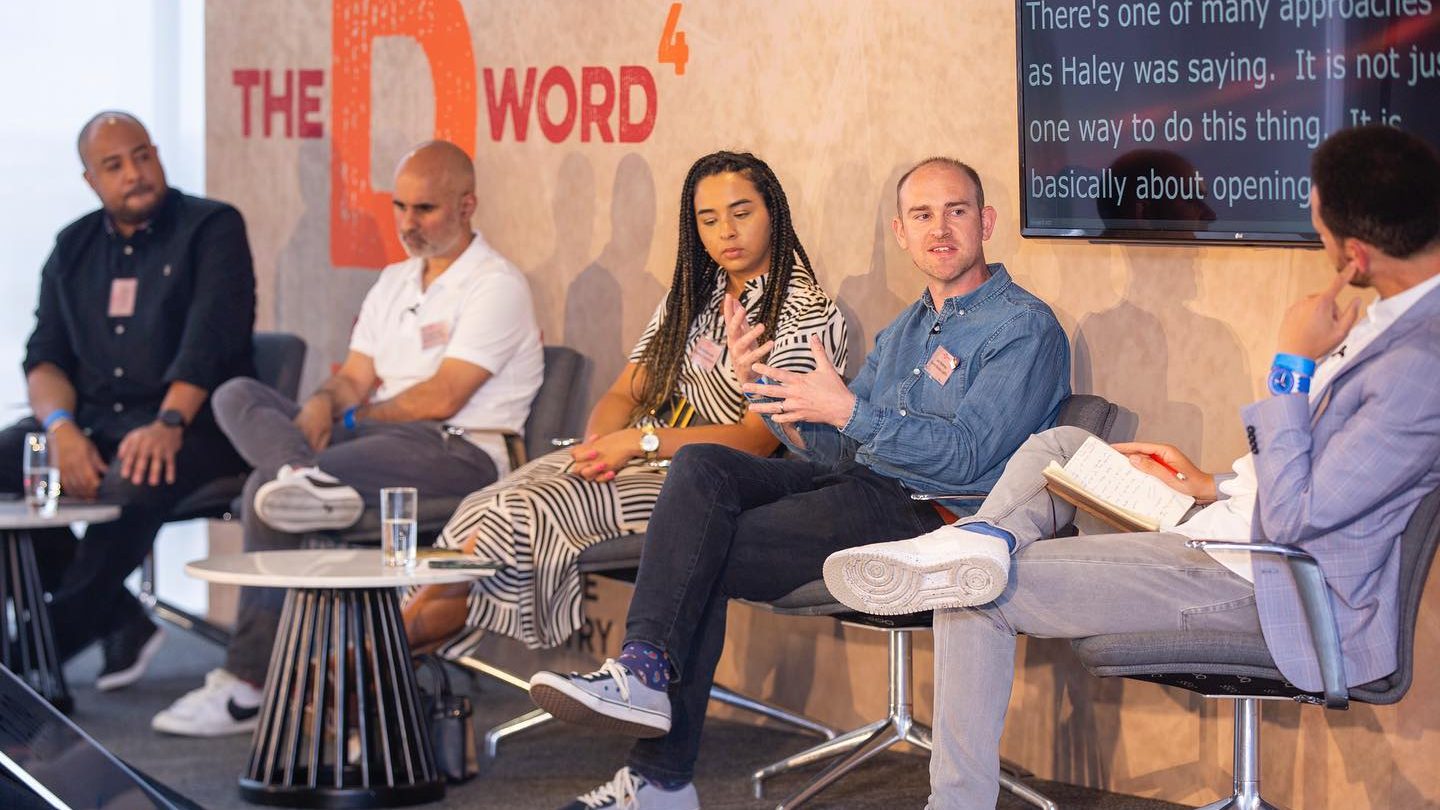
Key findings on the sports media industry, 2022

- 18% of LGBT+ people in sports media surveyed are either in the closet at work or are only out to their close work friends and colleagues (down from 45% in 2018)
- 29% of all people working in sports media who took our survey say they have witnessed or have been personally subjected to anti-LGBT+ language or behaviour in the workplace in the last two years (down from 45%)
- 28% of LGBT+ people in sports media that we surveyed either feel they have been discriminated against on the basis of sexual orientation or gender identity while looking for work or going for a promotion in the last two years, or feel that discrimination could have affected their career in this way (up from 18%)
- 14% of all people working in sports media who took our survey believe their industry is underperforming on inclusion for people who aren’t heterosexual (down from 30%)
- 81% of all people working in sports media who took our survey believe their industry is underperforming on inclusion for trans and non-binary people (up from 77%)
Background
On 29 June, Sports Media LGBT+ opened its second-ever survey to assess LGBT+ inclusion in sports media.
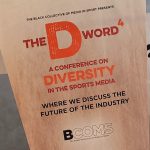
This followed on from our first survey held four years ago, and was again operated in line with BCOMS’ D Word Conference.
D Word 4 was held at News UK’s HQ in London on 6 July – we were able to share some initial responses at the event, while encouraging more of our industry colleagues to take the survey which we then ended by closing the Google Form on 16 July.
Back in 2018, our survey respondents told us about their experiences in the workplace, how welcoming they felt the industry was, and their thoughts on the media’s role in making sport more LGBT+ inclusive. Our lead Jon Holmes wrote about how the 2018 results showed…
… there are a significant number of employees in sports media who are LGBT+, but almost half of them appear to be highly guarded about their sexuality or gender identity… [while] another statistic – that more than half of LGBT+ people have witnessed or have been subjected to homophobic, biphobic or transphobic language or behaviour at work since 2016 – indicates how some individuals in the environments in which we work are the direct cause of discomfort or worse, discrimination, to those same LGBT+ employees.
So what’s changed since then? The 2022 survey was again open to all, and the responses gathered were anonymous.
Our 2022 survey results
The second survey received 71 responses in total, with 64 of those coming from people who say they are either currently working in sports media; have worked in the industry in the past; or are seeking employment in this sector.
Compared to 2018, we had less responses overall – but crucially, we did have more responses from LGBT+ people in sports media, which is ultimately our target demographic.
Here’s an overview of those who took the survey…
From that total pool of 71 respondents, the 64 ‘sports media people’ were then asked a series of further questions about their industry, while the seven people from outside sports media were taken to the end of the survey to answer a question about their perceptions of our industry (more on that later).
Here is some more information about the group of 64 ‘sports media people’ who took our survey in full…
- Location: Exactly half of the people who took the full survey in 2022 (32) said they were based in London and the South East; 17% said they were in the Midlands.
- Age: The majority of respondents (45%) were in the 25-34 bracket, with 22% aged 35-44.
- Ethnicity: 84% of respondents said they were white; the other 10 people taking the survey said they were black or mixed race, or they selected ‘other ethnic group’.
- Disability: Seven respondents (11%) said they considered themselves to be disabled.
- Gender: 53% selected male, 42% selected female, and three respondents said they were non-binary. Eight people in the group of 64 told us they identify differently to the gender they were assigned at birth.
- Sexuality: 36% told us they were gay men; 19% selected the ‘gay woman / lesbian’ option; while a further 19% of respondents told us they were straight. 14 respondents (22%) said they were either bisexual, pansexual, or queer.
Being out at work
We asked the 48 sports media respondents who said they were lesbian, gay, bi, pan or queer whether they were open about their sexual orientation in their respective workplaces…
We can see that, compared to 2018, this chart suggests greater LGBT+ visibility in the industry. That’s really encouraging and is what we would expect with the way our network group has grown.
However, the responses suggest that just under one in five LGBT+ people working in sports media are very guarded about their sexuality or gender identity.
In order to learn more about our respondents’ workplaces, we asked the following supplementary question…
Drawing upon your personal experiences in the sports media industry, how LGBT+-inclusive have you found the workplaces / work environments in which you have previously been employed or are currently employed?
Assessing the 39 responses we received, there were almost as many that rated their workplaces strongly on inclusion as there were who gave a moderately positive assessment. About a fifth of the comments gathered were from respondents who said their work environments were weak on inclusion.
Here are some of the responses…

- “There’s hesitancy from non-LGBT+ colleagues to approach the topic unless there are negative incidents”
- “The present company I work for could not be more inclusive – my colleagues seem genuinely interested. I did not feel comfortable coming out at my previous workplace, mainly due to the environment”
- “Every now and again, people who identify as straight don’t consider the impact that stories in the media can have on members of the LGBT+ community”
- “It has required LGBT+ people at the organisation / in the sport to launch a network to be recognised. There was very little recognition beforehand”
- “I think many LGBT+ people are not out in the sports media industry because they don’t know how they will be perceived by their colleagues. There are no protocols or definitions in most places about them being welcome too”
- “I’m the only LGBT+ person working in sports media that I know of after 3+ years. The environment I’m in is welcoming, accepting and kind. Due to being the only queer person employed, I feel that there is a general misuse of terminology surrounding trans people. I don’t believe this comes from a place of hate but a lack of awareness”
- “There are definite examples of indirect discrimination but this may be due to a lack of knowledge and awareness rather than malice. There continues to be a fear and reticence to talk or listen”
- “As far as I know, I’m the only LGBT+ person in my team, and one of two or three maximum in our office of 60. But it’s a very friendly, open environment, and we had an LGBT+ talk for Pride which was really well attended and well received”
- “The least inclusive spaces have been the LGBT+ ones. The racism and the lack of accountability makes it very difficult”
- “There are no active initiatives to increase/promote inclusivity but no exclusionary behaviour either”
- “Everything I’ve seen says to me that if I were open about being trans, it could end my career and cost me the peer respect I’ve spent many years building”
- “It feels like in a lot of the spaces I work in, we’ve graduated to a post- post- awareness of LGBT+ people and their concerns. Not necessarily in a bad way, but in a way that is pretty much ‘we’re past that’ – when in fact we’re not”
A theme that came through here was that it’s still common for LGBT+ people in sports media to feel like they are the only ones in their workplace – this demonstrates the importance and value of a cross-industry network group like ours. Although mentioning your sexuality appears to be less of a hurdle generally than in 2018, talking openly about your gender identity for those who are trans or non-binary is a significantly greater concern.
Workplace attitudes
We asked the group of 64 ‘sports media people’ (both those who are LGBT+, and those who aren’t) the following question…
Have you personally witnessed, or been subjected to, anti-LGBT+ language or behaviour in a sports media industry workplace setting in the last two years?
Six people said the question was not applicable to them or that they couldn’t be sure.
Of the 58 remaining respondents, 29% answered ‘Yes‘ to the question.

Returning to the survey comments, there was a certain amount of benefit of the doubt given to colleagues. In workplaces where we were told that anti-LGBT+ language had been used, blame was partly apportioned to senior leaders if they were viewed to be failing on inclusion.
Meanwhile, looking solely at the 48 definitive responses to the question which were given by those who told us they were LGBT+, 31% said ‘Yes’.
We also asked the same group of 64 sports media respondents…
Have you felt discriminated against while looking for work or seeking a promotion in the sports media industry for reasons of sexual orientation and/or gender identity in the last two years?
Six people told us the question was not applicable to them. Out of the remaining 58 responses, 7% answered ‘Yes’, with a further 21% answering ‘Not sure’.
This result represented an increase on the equivalent from 2018. The majority of the survey respondents who were trans or non-binary people were within the 28% figure.
LGBT+ inclusion in the sports media industry
Next, we asked the group of 64 ‘sports media people’ to give two overall grades to their industry on LGBT+ inclusion – one relating to sexual orientation, the other relating to gender identity (one respondent did not answer the sexuality question).
For both graphs below, a grade of 1 represents ‘not at all inclusive’, while a grade of 5 represents ‘very inclusive’.
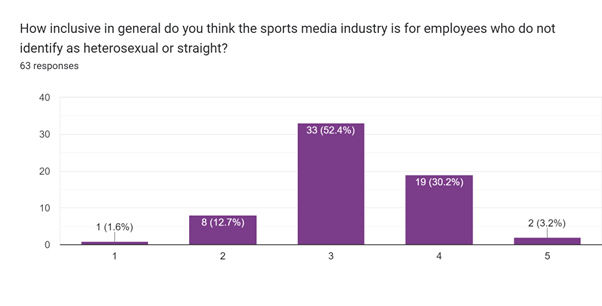
Just like in 2018, only two respondents said they thought sports media was ‘very inclusive’ of lesbian, gay, bi and pan people. However, compared to four years ago when more than 30% of respondents felt the industry was underperforming on inclusion for people who aren’t straight, that figure has now fallen to 14%.
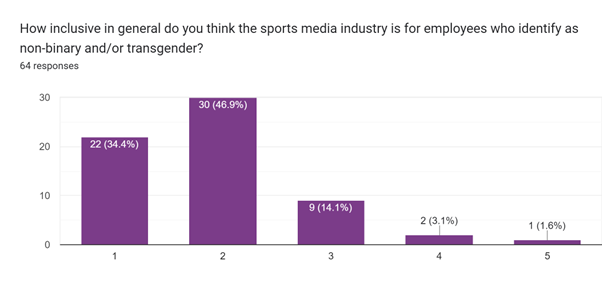
However, on gender identity, there is a slight increase in the percentage of respondents who felt the industry is underperforming on inclusion for people who are trans or non-binary (from 77% to 81%).
The suggestion here is that as LGBTQ+ visibility increases, the industry is becoming more welcoming for those who are lesbian, gay, bi and pan – but the perception is that for people who are trans and non-binary, it’s still very challenging to work in sports media.
In a follow-up question, we asked…
What steps, if any, should sports media employers be taking to support LGBT+ inclusion in the industry?
A selection of the 38 responses are below…
- “We just want to be able to have an open dialogue about things that might worry us – and make sure there’s someone to talk to”
- “Sports media is way behind, not just with the LGBTQ+ community but in including women and minorities – anyone who isn’t a straight, white (middle class) man – I think all of us who fall outside that need to form an alliance and work together… we would all be stronger working together for the greater good”
- “Making sure that they are in a safe environment and have the same conditions as their peers to grow within the company, and zero tolerance protocols to those who commit discrimination”
- “Basic EDI training would help with general awareness (not assuming that a man would have a wife/girlfriend and vice versa). Action from leadership to ensure that an old-school dressing room banter culture does not take hold in the workplace (the sports industry is particularly vulnerable to this). Activations around Pride month always welcome”
- “Representation in senior positions for me is crucial in creating inclusive environments and also it’s important to ensure that there is representation at all levels, because each person will probably be affecting output”
- “I think it’s also really important to show signs of inclusivity; whether that’s having a LGBT+ network or celebrating Pride”
- “Thanks to the entirely understandable grey area of trans participation in sports being so widely ‘debated’ of late, I’ve found the levels of active transphobia (rather than simply passive or ignorance) in the sports industry significantly higher than any other industry I have worked in or area of life I have personally experienced”
The majority of comments we received asked for greater engagement with and encouragement of LGBTQ+ staff. When senior leaders didn’t acknowledge this demographic of employees, there was frustration and sometimes disillusionment, and the perception was that this negatively affected both recruitment and output. There was a strong desire voiced for specific LGBTQ+ education in newsrooms.
Covering LGBT+ stories in sport
For 2022, we included a new section to learn more about the connection between LGBT+ people working in sports media and the coverage that stories about being LGBT+ in sport receive.
How confident are you personally in covering stories related to sexual orientation in sport?
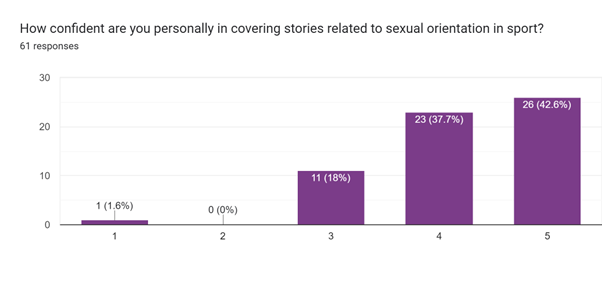
Encouragingly, over 80% of respondents said they have above-average confidence or are very confident when it comes to producing content about sexuality in sport.
How confident are you personally in covering stories related to gender identity in sport?
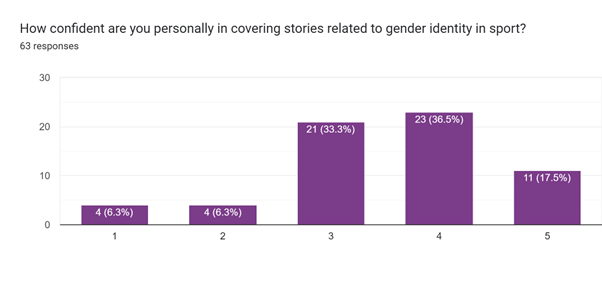
Only 54% of respondents answering this question said they have above-average confidence or are very confident when it comes to producing content about gender identity in sport.
We also asked the group of 64 ‘sports media people’ the following…
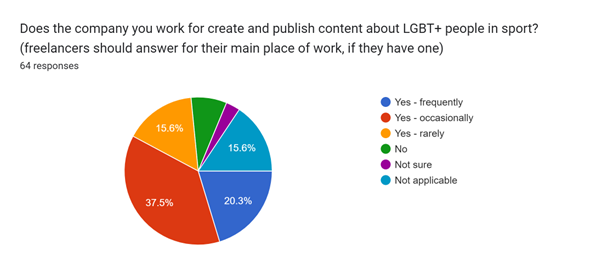
With 10 respondents saying the question was not applicable to them, it meant over 57% said their companies either frequently or occasionally published content about LGBT+ people in sport.
However, over 23% of those surveyed said the outlets they work for rarely or never covered LGBT+ people in sport. We asked these respondents for more information…
In your view, why does the company you work for rarely or never create and publish content about LGBT+ people in sport?
Some of the 12 written answers we received…
- “I feel that I’m the only driving force within the business who cares about this”
- “Perceived lack of audience interest, lack of experience and awareness among the managers and most of the main journalists”
- “They’re scared to get it wrong”
- “I’ve felt like I’m hitting my head on a ceiling… I don’t feel the push is communal or fully purposed from where it should be”
These responses further indicate the problems caused by a lack of engagement as mentioned earlier, with LGBT+ employees feeling underappreciated while also having a sense of personal responsibility to be the change they want to see. The perceived failings of senior leadership, combined with the nervousness and reticence of newsroom colleagues, add to the frustration.
The media’s role in LGBT+ inclusion in sport
The final survey question was open to all 71 respondents who took the survey…
How would you assess the contributions of both the sports media and the wider media on LGBT+ inclusion in sport? Please provide examples that you feel have had positive and negative impacts.
Here is a selection of the 49 answers we received…
- “Sports media has been very good on the L and G part, with profiles of sports people coming out and sympathetic coverage. Unfortunately, like with the wider UK media, there’s a lot of hysteria when it comes to trans athletes though, which has been widely destructive in terms of the rights of trans people in society in general. Trans people aren’t given as sympathetic a hearing as they should”
- “There needs to be more on issues like bisexuality and not just gay or lesbian athletes”
- “There needs to be more variety in stories beyond coming out stories, to show the varied and nuanced stories of LGBT+ people in sport and the rich contributions these athletes and administrators make to sport”
- “I started working in sport in 2013 and experienced some nasty comments, albeit speculative. But I wasn’t out at the time and it hurt. If I had seen the coverage that the issue has now back then, I may have come to terms with things quicker and easier”
- “The coming out of players shouldn’t be speculated about and trans issues must be covered in a sensitive way as well. I think certain publications miss the mark by a long way in a quest for views”
- “The battle is close to being won when it comes to covering LGB issues in sport. Unfortunately, there is a tendency in some parts of the media to sensationalise and to some degree demonise trans athletes and participants in sport… the media should try to remember that there are humans at the heart of these stories”
- “The gay footballer witch-hunt led by The Sun and The Mail have had an obvious and insidious negative impact. Adam Crafton’s reporting on LGBT+ Saudis is often mentioned to me by straight colleagues as something which resonated – perhaps by anchoring LGBT+ campaigning themes into something both tangible (rights, legal issues) but still personal”
- “In the areas of punditry, commentary and in women’s sport, we’re seeing so many more LGBTQ+ people being their authentic selves and it’s fantastic. For male athletes however, there is a lot left to do, and the trans ‘debate’ threatens to divide and destroy the good work done by creating new ways of excluding those who are different”
- “Giving such airtime and space to uninformed people to spout harmful rhetoric… the trans people in sport debate is just another stick to beat the trans community with”
- “I know of journalists who wish to report in a more balanced or positive way about trans athletes but their editors/desks are less inclined to do so”
- “Seeing clubs take ownership of the coming out stories of their athletes seems a much more positive way to support people than media outlets outing them. Hope we see more of that”
- “The current trans ‘panic’ has been so sad to see, and I think it has limited organisations from shouting proudly about their networks and activities because of the barrage of activists online, and vocal people in sports”
- “The general culture wars in the country, stoked by some in Government, is going to impact contributions going forward. We can already see it”
- “It’s obvious when there are LGBT+ journalists working in a certain outlet which proves why diversity is imperative in newsrooms”
- “The trans debate is largely toxic, whichever side of the fence you sit, and has turned into abuse for those writing about it and more importantly for trans people and athletes”
- “Messaging has improved but still lacks diversity. It also continues to understate the importance of allyship, placing emphasis on representation and the community to advocate for itself”
- “Can be a bit performative and ‘freakshowish’… when there is more than one token LGBT+ person on the executive, editorial and production sides, then people can start to see real representation”
- “Mixed. The coverage of Josh Cavallo and Jake Daniels’ coming outs were pretty much perfectly done by most outlets. There has also been visibly increasing coverage of LGBT+ sport at the grassroots level, which can only help inclusion. But there are still incidents of the ‘guess the gay footballer’ articles which only harm things. There has also been a hostile approach to trans people participating in sport, with that part of the community having virtually no voice. So in some ways, things are definitely better than ever, but in others, backwards steps are being taken”
- “The slow rise of openly queer sportspeople is made possible by openly queer members of the media, under less scrutiny and less part of any toxic environments… Exposure and representation is what’s needed to show the average fan who has no queer friends that this is entirely normal”
- “Coverage of some members of the England women’s football team and also the Barclays WSL, plus other international players, demonstrating their comfort and confidence in their relationships and identity, has become much more normal and accepted. Without sensationalising these examples, coverage reassures and empowers those who see, listen and read about them”
Conclusions
Jon Holmes, Sports Media LGBT+ founder and network lead, writes…
November 2022 will mark five years since the launch of Sports Media LGBT+ and in that time, the contributions of lesbian, gay, bi and trans people working in the industry has been demonstrable and impactful.
In the UK, we are now well into the double digits in terms of journalists and editors who are LGBT+ and out in our industry – and a sizeable proportion of this group are telling stories about the experiences of LGBT+ people in sport that resonate strongly with audiences. They are being supported in this by active allies, working alongside them as colleagues and often in more senior positions too.
Since our last survey in 2018, we’ve seen the growth and success of the BBC LGBT Sport Podcast, created and hosted by Jack Murley; continuing support for the Rainbow Laces campaign on Sky Sports; the establishment of The Athletic UK, which often produces long-form, detailed articles that expand on LGBT+ talking points in football; as well as content on BT Sport, CNN, Goal.com, Mirror Sport, the i paper, and more outlets.
The 2022 survey results indicate a strong correlation between LGBT+ visibility in the workplace and responsible reporting.
As a network, we increasingly know when journalists who are LGBT+ themselves are involved in creating and producing content about the community. Their guidance helps to ensure that output about athletes and other sportspeople who are lesbian, gay, bi and trans has greater nuance and depth, certainly when compared to that of a decade ago.
However, the survey comments suggest that where visibility is low in sports media workplaces, the quality of reporting on LGBT+ stories in sport is less reliable.
Some of this will stem from LGBT+ employees in these workplaces not contributing because they do not feel acknowledged and valued. They may not be out to anyone at work, or only to close friends; their self-confidence is affected; and feelings of isolation can be exacerbated by the indifference of others, whether perceived or real. In the worst instances, the newsroom culture is unwelcoming due to incidents of LGBT+-phobia.
Clearly, the industry is still seen to be very challenging indeed for people who are trans or non-binary. Responses to the survey indicated how editors and other influential figures in some office environments, who might be expected to lead by example, could not be depended upon to set the tone for inclusion.
Does output reflect this? Some comments expressed a view that the sensationalism of yesteryear was shifting away from gay and bi male footballers and onto trans athletes. Amid the ongoing chase for clicks and newspaper sales, fuelled by polarised reactions on social media, there is less time and space to show humanity, personality and allyship.
We hope that the survey results above demonstrate that when staff who are LGBT+ feel more empowered to be their authentic selves at work, they are more engaged and productive. In sports media terms, this tends to mean delivering content and driving awareness.
Over time, these employees see change happening around them and are vocal about being proud to work for their complany, which helps to attract and retain talent. Meanwhile, as journalists with a public profile, their visibility encourages the consumption of content by the wider community of LGBT+ people and allies.
Athletes and coaches who are LGBT+ are more likely to trust not just these individual journalists, but also the outlets they work for. Gradually, an appreciation develops at a senior level of this intertwined relationship between LGBT+ staff, newsroom and boardroom allies, and the community.
The more that this understanding is woven into the fabric of organisations, the better.
This summary was adapted from a keynote talk given by Jon at the Sports Media Identity Network session on September 23.
Thanks to all those who took our survey, and for reading through the results.
You can get in touch with Sports Media LGBT+ by using our Contact form or by emailing us at info@sportsmedialgbt.com.
Further reading…
Emma Smith: Sluggish steps suggest sports media is still too cushy on diversity
Intersectionality at heart of advice to industry in new BCOMS’ D Word 4 Diversity Guide
Sports Media LGBT+ is a network, advocacy, and consultancy group that is helping to build a community of LGBTQ+ people and allies in sport. Learn more about us here.
We’re interested in your news and stories. Share with us and tap into a worldwide audience through our Google News affiliate website and our popular social channels with over 10,000 followers. Contact us to discuss how we can help you.
